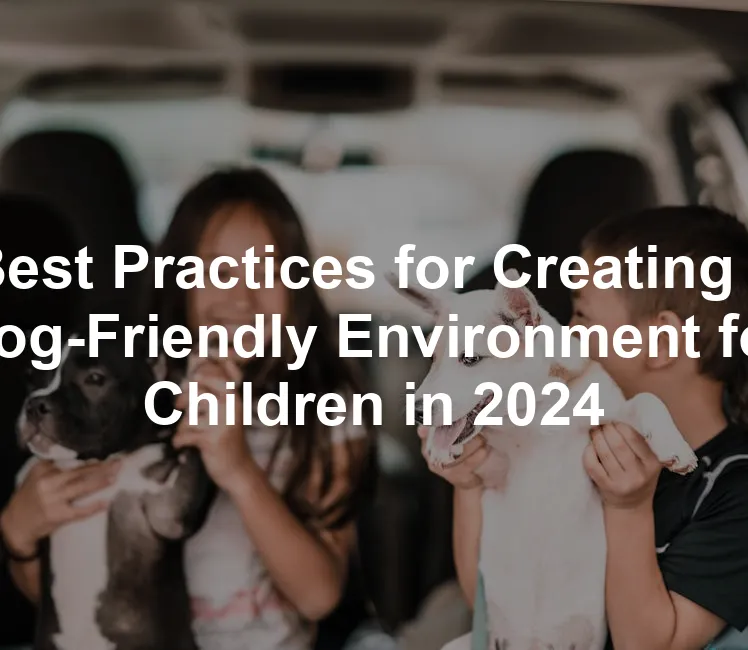Understanding the Benefits of Pets for Children
Having a pet can be a game changer for kids! It’s not just about wagging tails and playful barks; there’s a treasure trove of benefits. First off, pets teach responsibility. Kids learn to feed, groom, and care for their furry friends, fostering a sense of accountability. Who knew that while they’re filling the dog’s bowl, they’re also building life skills?
Moreover, pets are fantastic for teaching empathy. Children learn to understand their pet’s feelings, which can enhance their emotional intelligence. It’s not just about fetching a ball; it’s about understanding when their dog is feeling blue or just wants a cozy cuddle.
Statistics reveal that over 70% of American families have pets, and studies show that kids with pets tend to have better social skills. They learn to share, communicate, and even negotiate playtime! A pet can be a child’s first friend, teaching them how to connect with others.
Pets also provide comfort during tough times. They’re like fluffy therapists, always there for a snuggle after a tough day at school. So, in short, pets enrich childhood experiences and contribute to happier, healthier kids. What’s not to love about that?

To make those moments even better, consider using a Dog Training Clicker. It’s a fun way to teach your pooch new tricks and keep your kids involved in the process. Plus, it’s a great tool to reinforce positive behavior while building that special bond!
Preparing Your Home for Safety
Pet-Proofing Your Space
Creating a safe home for both kids and dogs involves some thoughtful planning. Start by identifying potential hazards. Electrical cords? Secure them with clips. Chemicals? Lock them up tight! Little ones are curious, and dogs are too, so let’s keep them safe.
Designated pet areas are essential. Create a cozy nook for your dog with their food, water, and toys. This gives your furry friend a space to relax, away from the hustle and bustle. Child-free zones are equally important. Use baby gates to keep rambunctious kids from entering your pet’s space during mealtime or quiet time.
Another tip? Keep small items off the floor. Toys and shoes can become chew toys in a heartbeat! Regularly check your home for items that could pose a risk. It’s like a treasure hunt, but instead of gold, you’re searching for hazards.
Also, think about your furniture. Ensure it’s durable and easy to clean. Leather or microfiber can withstand playful paws and messy spills. Avoid sharp edges that could harm both kids and pets during their adventures together.
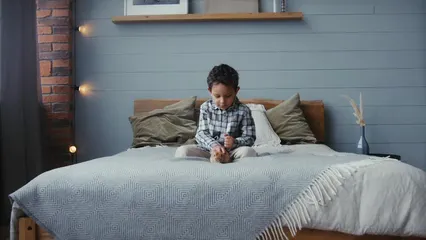
Creating a Safe Environment
Establishing a “chill out zone” for dogs is crucial. This is their sanctuary, away from playful kids. Make it comfy with blankets and toys. It’s where they can recharge without interruption.
For kids, designate safe play areas, too. Use baby gates to create a safe space where they can play without worrying about a dog’s enthusiastic tail wagging or curious sniffs.
Effective barriers can work wonders. Baby gates or pet barriers prevent unexpected encounters during high-energy moments. This keeps both pets and children safe, reducing the risk of accidents.
Remember, always supervise interactions. Even the friendliest dog can become overwhelmed during playtime. Teaching children to respect a dog’s space is essential. With these tips, you’ll create a harmonious home where everyone can thrive together.
Incorporating these safety measures will not only protect your little ones and your fur babies but will also help foster a loving environment. By taking the time to prepare your home, you can ensure that both children and dogs coexist happily, creating memories that last a lifetime.
Supervising Interactions
The Golden Rule of Supervision
When it comes to children and dogs, the golden rule is simple: never leave them alone together. Even the most friendly dog can react unpredictably. Accidents can happen in the blink of an eye! Always keep a watchful eye on their interactions. Stay within arm’s reach, and don’t let distractions like phones or TV steal your focus.
Being alert helps you recognize when to intervene. If playtime gets too rowdy or your dog shows signs of discomfort, step in. Your quick reaction can prevent issues before they escalate. Remember, safety first!
Teaching Children How to Interact with Dogs
Coaching your little ones on how to interact with dogs is crucial. Teach them the art of gentle petting and appropriate play. Remind them that dogs, like people, have feelings too!
Signs of a dog feeling uncomfortable include growling or lip licking. Educating kids to recognize these cues empowers them to respect a dog’s boundaries. Explain the importance of giving dogs their space, especially when they’re eating or resting. By instilling these lessons, you create a harmonious environment where both children and dogs can thrive together.
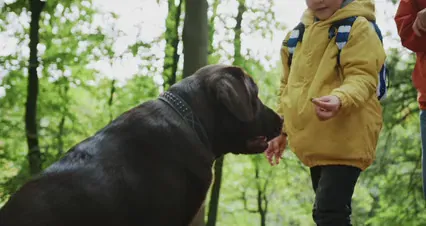
Training and Socialization
Training Your Dog
Training is essential for a dog-friendly environment. Basic commands like sit, stay, and leave it are not just party tricks—they’re vital for safety. A well-trained dog is more manageable around children. Reinforcing positive behavior around kids is equally important. Celebrate good manners with treats and praise!
Make training a fun experience for your pup. Use games and positive reinforcement to encourage learning. This builds a trusting relationship that ensures both your dog and kids feel secure. To help with training, consider investing in Dog Training Treats that make rewarding good behavior a tasty treat!
Involving Your Child in Training
Involving your child in training sessions can be a delightful bonding experience. Encourage them to help with simple commands. Let them hold the leash during walks, teaching responsibility and leadership skills.
Fun activities, such as trick training or agility exercises, foster interaction between kids and dogs. These shared moments build trust and friendship. Remember, a well-exercised dog is a happy dog, making playtime even more enjoyable! By integrating children into the training process, you create lasting memories and a stronger bond between your family and furry friend.

Teaching Children About Dog Body Language
Understanding dog body language is crucial for safe interactions between children and their furry friends. Dogs communicate primarily through their bodies. Recognizing signs of discomfort can prevent accidents. For instance, a tucked tail often indicates fear or anxiety. Ears pointing back can signal unease or submission. A dog that is freezing, lip licking, or yawning might be feeling stressed. Teaching children to spot these signals is essential. It empowers them to interact safely with dogs and fosters empathy for their feelings.
Children need practical knowledge of what to look for. Imagine a child approaching a dog with a wagging tail. The dog seems friendly, but if its ears are pinned back, it may not be in the mood for interaction. Another scenario: a child is excitedly trying to hug their dog, but the dog is growling softly. This is a clear warning. Teaching kids to pause and assess the dog’s body language can prevent misunderstandings.
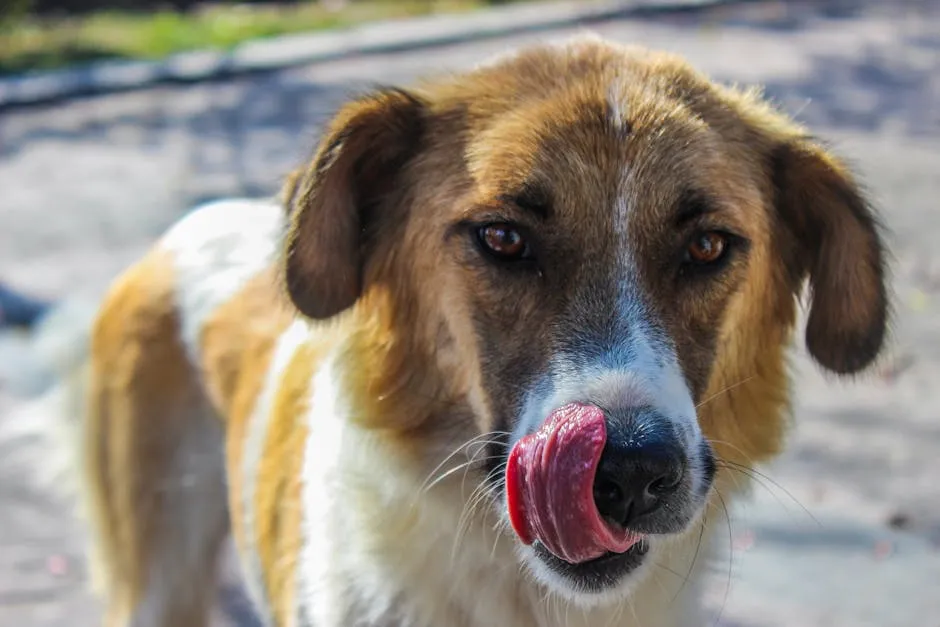
Incorporating these lessons into everyday life can be fun. Role-playing different scenarios helps children learn how to approach dogs. Use stuffed animals to demonstrate positive and negative interactions. For example, show how a gentle approach with an outstretched hand can lead to a happy greeting. Conversely, illustrate how invading a dog’s space can lead to stress or aggression.
It’s vital to remind children that not all dogs are the same. Each dog has its unique personality and comfort level. Teaching them to ask the owner for permission before petting an unfamiliar dog sets a great example. This way, children learn to respect dogs’ boundaries from an early age. By understanding dog body language, children build a foundation for safe, loving relationships with pets.
Creating a Positive Environment
Creating a positive environment for both dogs and kids involves engaging activities that foster bonding and respect. Safe games are a fantastic way to promote interaction. Think fetch or hide-and-seek but with a twist. For fetch, ensure the dog has a soft toy to retrieve. This keeps playtime enjoyable and safe. Hide-and-seek encourages dogs to find a family member, strengthening their bond.
Involving children in daily walks is beneficial too. Kids can help hold the leash, making them feel responsible. It’s a great opportunity to teach them about proper leash handling. While walking, encourage your child to observe the dog’s behavior. Is it excited, relaxed, or distracted? This builds awareness and empathy, vital traits for interacting with pets.

Training sessions can also be a fun family affair. Teach the dog new tricks, and let the kids be part of the process. Children can reward the dog with treats for a job well done. This not only reinforces training but also builds teamwork. Moreover, it helps kids understand the importance of patience and consistency in training.
Another engaging activity is creating DIY dog toys together. Use old socks or t-shirts to make tug toys. This encourages creativity and reinforces the idea of caring for pets. Plus, it’s a fun way to recycle! Remember, the more involved kids are, the more they’ll appreciate their four-legged friends.
Creating DIY dog toys is a fun way to engage children and teach them about caring for pets. DIY dog toys using household items
Encouraging gentle handling is crucial in a dog-friendly environment. Teach kids to approach dogs calmly and quietly. Show them to avoid sudden movements that might scare a dog. A simple “no face-level interaction” rule is essential. This rule helps prevent accidental bites, especially from nervous dogs. Instead, teach them to pet dogs gently on the back or sides, avoiding the head and tail.
By fostering these positive interactions and creating a safe environment, you ensure that both kids and dogs can thrive together. A little guidance goes a long way in building lasting friendships between your children and their furry companions.
Conclusion
Creating a dog-friendly environment for children isn’t just about ensuring safety; it’s about fostering a relationship that benefits both parties. By implementing these best practices, you can nurture a loving and secure home where both your children and furry friends thrive. Remember, the journey is about patience, vigilance, and a sprinkle of love! With proper preparation, training, and supervision, you can create a harmonious atmosphere that allows kids and dogs to coexist happily. This bond isn’t just beneficial; it’s magical. So, lace up those shoes, grab a leash, and let the adventures begin!
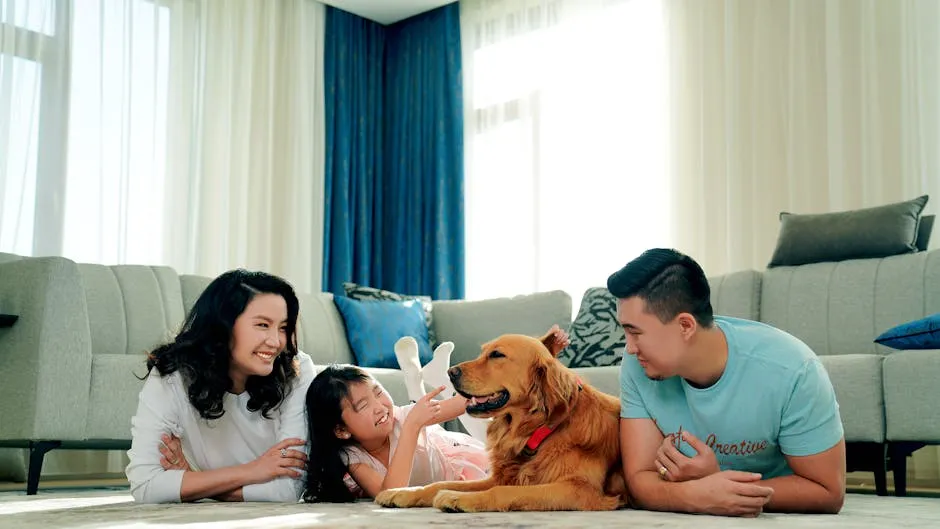
And speaking of leashes, if you’re looking for a durable option, check out this Dog Leash that can withstand all the tugging and pulling during those playful walks!
FAQs
What age is appropriate for children to interact with dogs?
Generally, children aged five and older are ready. Younger kids may need more supervision and guidance. Every child is different, though, so consider their maturity and understanding of pet care before introducing a dog.
How can I teach my child to be gentle with dogs?
Start with simple lessons. Show your child how to pet dogs gently and avoid sudden movements. Use phrases like “gentle hands” to reinforce positive behavior. Practicing with stuffed animals can help them understand appropriate interactions.
What should I do if my child gets bitten?
Stay calm! First, clean the bite with soap and water. Seek medical attention, especially if the bite breaks the skin. It’s also important to understand what led to the incident, ensuring it doesn’t happen again.
How can I prepare my dog for a new baby?
Gradually introduce changes to your dog’s routine. Play recordings of baby sounds, and establish safe spaces for both baby and dog. Practice walking with the stroller to help your dog adjust to new dynamics.
Are there specific breeds that are better with children?
Yes! Breeds like Labrador Retrievers, Golden Retrievers, and Beagles tend to be gentle and friendly with kids. However, each dog has its own personality, so always assess individual temperaments when choosing a pet for your family.
Please let us know what you think about our content by leaving a comment down below!
Thank you for reading till here 🙂
And if you’re looking for a comfy spot for your furry friend, don’t forget to check out this amazing Dog Bed that offers the perfect blend of comfort and support for those long naps.
And let’s not forget the essentials! Keeping your dog hydrated is key, so consider a Dog Food and Water Dispenser that makes feeding time a breeze!
All images from Pexels

